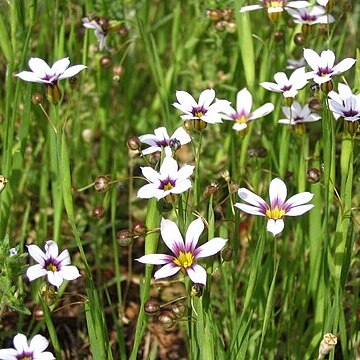Herbs, perennial, cespitose, yellowish to light olive when dry, to 5.7 dm, not glaucous. Stems branched, with 1 or 2 nodes, 0.8–1.9 mm wide, usually glabrous, margins entire, similar in color and texture to stem body; first internode 11–36 cm, longer than leaves; distalmost node with 2–3 branches. Leaf blades usually glabrous, bases occasionally becoming fibrous, but not persistent in tufts. Inflorescences borne singly; spathes green or occasionally with purplish tinge on margins, obviously wider than supporting branch, glabrous or slightly scabrous, keels entire; outer 12–16.1 mm, 1.4 mm shorter to 1.5 mm longer than inner, tapering evenly towards apex, margins basally connate 3–5.2 mm; inner with keel evenly curved or straight, hyaline margins 0.2–0.6 mm wide, apex broadly rounded to truncate, usually erose, ending 0–0.5 mm proximal to green apex or, occasionally, exceeding it by up to 0.5 mm. Flowers: tepals light blue or bluish violet to purple or occasionally white, bases yellow; outer tepals 6.3–11 mm, apex emarginate to truncate, aristate; filaments connate ± entirely, stipitate-glandular basally; ovary blackish, in contrast with much lighter foliage. Capsules dark brown to black or purplish black, ± globose to obovoid, 2–4.1 mm; pedicel ascending to erect. Seeds globose to obconic, lacking obvious depression, 0.5–1.2 mm, rugulose or occasionally granular. 2n = 16, 32.
More
Light green, somewhat glaucous, usually drying pale, ± spreading and often forming small tussocks; stem slender and wiry, 0.5–2 mm wide, the smooth-margined wings distinctly narrower than the central portion; lvs 1–3 mm wide; spathes evidently peduncled from the axils of lf-like bracts, the stem tending to be geniculate at the nodes and the spathes likewise often geniculate on the peduncles; outer bract of the spathe mostly 1.5–2 cm, its margins connate for 2.5–4 mm at base; inner bract not much shorter than the outer; tep 8–12 mm, blue-violet; fr 3–5 mm; 2n=16, 32, 96. Fields, meadows, open woods, and edges of salt marshes; N.S. and Me., s. in the coastal states to Fla. and Miss., and locally inland to Mich., Ind., Minn., and Mo. (S. strictum)

